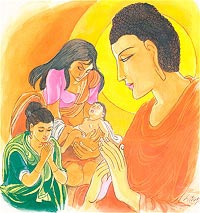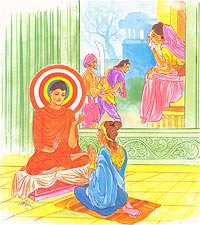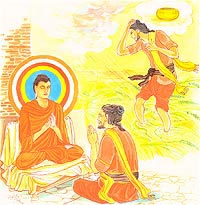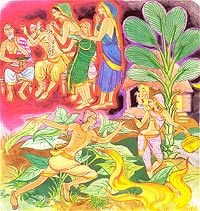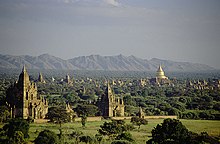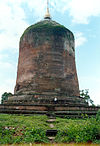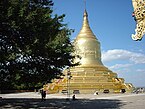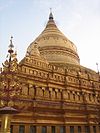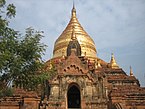ASHOKA
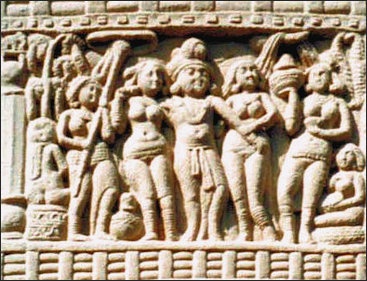
Ashoka and his two queens at Sanchi
Emperor Asoka (born 304 B.C.,ruled 274-236 B.C.) was
arguably the greatest ruler in Indian history and was the man who
ensured Buddhism success as a world religion. After Asoka conquered the
kingdom of Kalinga, in one of most important battles in the history of
the world, near the Brubaneswar airport in the state of Orissa, he was
so appalled by the number of people that were massacred (perhaps 100,000
or more) he converted himself and his kingdom to Buddhism and sent
Buddhist missionaries to the four corners of Asia to spread the
religion. The wheel Asoka used to symbolize his conversion to Buddhism
is the same one pictured on India’s flag today. H.G. Wells, a noted
historian as well as science fiction writer, wrote: “Amidst the tens of
thousands of names of monarchs that crowd the columns of history … the
name of Ashoka shines, and shines almost alone, a star.”
As the leader of the Maurya Empire Ashoka unified all
of the subcontinent except the southern tip and put all of India under
unified control for the first time. An early convert to Buddhism, his
regime was remembered for its sectarian tolerance, as well as for
remarkable administrative, legal, and cultural achievements. Under
Ashoka, Buddhism was widely propagated and spread to Sri Lanka and
Southeast Asia. Many Buddhist monuments and elaborately carved cave
temples found at Sarnath, Ajanta, Bodhgaya, and other places in India
date from the reigns of Ashoka and his Buddhist successors.
According to PBS: Ashoka “ruled over a territory
stretching from the northern Himalayas into peninsular India and across
the widest part of the subcontinent. Known for his principles of
non-violence and religious tolerance, Ashoka modeled himself as a
cakravartin, the Buddhist term for a “universal ruler,” whose rule was
based on the principle of dharma or conquest not by war but
righteousness. To advance this principle, Ashoka had edicts based on the
dharma carved on rocks, pillars, and caves throughout his kingdom and
sent emissaries abroad to disseminate his views.” [Source: PBS, The
Story of India, pbs.org/thestoryofindia]
Steven M. Kossak and Edith W. Watts from The
Metropolitan Museum of Art wrote: “ The Mauryan emperor Ashoka (272–231
B.C.), a great military leader, conquered a large part of India. As a
reaction to the horrors of war, he converted to Buddhism. To bring the
Buddha’s teachings to his people, Ashoka built stupas throughout his
kingdom. He also introduced a system of writing, which had been absent
in India since the collapse of the Indus Valley civilization. When the
Mauryan dynasty came to an end in the second century B.C., India was
once again divided into smaller kingdoms. However, Buddhism continued to
spread, and with it the building of stone stupas and meeting halls.
<> [Source: Steven M. Kossak and Edith W. Watts, The Art of
South, and Southeast Asia, The Metropolitan Museum of Art, New York]
Websites and Resources on Buddhism: Buddha Net buddhanet.net/e-learning/basic-guide ; Religious Tolerance Page religioustolerance.org/buddhism ; Wikipedia article Wikipedia ; Internet Sacred Texts Archive sacred-texts.com/bud/index ; Introduction to Buddhism webspace.ship.edu/cgboer/buddhaintro ;
Early Buddhist texts, translations, and parallels, SuttaCentral suttacentral.net ;
East Asian Buddhist Studies: A Reference Guide, UCLA web.archive.org ; View on Buddhism viewonbuddhism.org ;
Tricycle: The Buddhist Review tricycle.org ;
BBC - Religion: Buddhism bbc.co.uk/religion ;
Buddhist Centre thebuddhistcentre.com; A sketch of the Buddha’s Life accesstoinsight.org ;
What Was The Buddha Like? by Ven S. Dhammika buddhanet.net ;
Jataka Tales (Stories About Buddha) sacred-texts.com ;
Illustrated Jataka Tales and Buddhist stories ignca.nic.in/jatak ;
Buddhist Tales buddhanet.net ; Arahants, Buddhas and Bodhisattvas by Bhikkhu Bodhi accesstoinsight.org ; Victoria and Albert Museum vam.ac.uk/collections/asia/asia_features/buddhism/index
See Separate Article MAURYA EMPIRE factsanddetails.com ; ASHOKA’S EDICTS, PILLARS AND ROCKS factsanddetails.com
Ashoka and the Maurya Empire
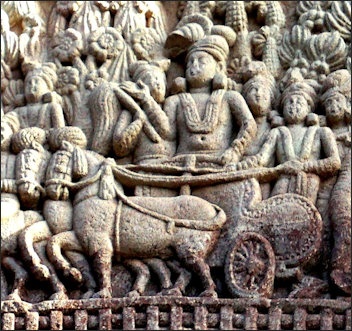
Ashoka visiting Ramagrama stupa, from Sanchi Stupa 1 Southern gateway
The Maurya empire reached its zenith under Ashoka (273
and 232 B.C.)., who conquered most of the Indian subcontinent and then
made Buddhism the state religion. The grandson of Chandragupta, Ashoka
inscribed edicts Buddhist tenants on pillars throughout India,
downplayed the caste system and tried to end expensive sacrificial
rites.
According to PBS: His “exemplary story remains popular
in folk plays and legends across southern Asia. The emperor ruled a vast
territory that stretched from the Bay of Bengal to Kandahar and from
the North-West Frontier of Pakistan to below the Krishna River in
southern India. The year 261 B.C. marks a turning point in Ashoka’s
reign when, in part to increase access to the Ganges River, he conquered
the east coast kingdom of Kalinga. By Ashoka’s account, more than
250,000 people were killed, made captive or later died of starvation.
Feeling remorseful about this massive suffering and loss, the emperor
converted to Buddhism and made dharma, or dhamma, the central foundation
of his personal and political life…To some historians, the edicts
unified an extended empire, one that was organized into five parts
governed by Ashoka and four governors. After his reign, Ashoka has
become an enduring symbol of enlightened rule, non-violence, and
religious tolerance. In 1950, the Lion Capital of Ashoka, a sandstone
sculpture erected in 250 B.C., was adopted as India’s official emblem by
then Prime Minister Jawaharlal Nehru. [Source: PBS, The Story of
India, pbs.org/thestoryofindia]
Ashoka and his predecessors and descendants created the
largest ever Indian empire—stretching from present-day Myanmar (Burma)
to Afghanistan and Sri Lanka. Ashoka is regarded as the first leader to
conquer the world “in the name of religion and universal peace.” Ashoka
established a stable kingdom that lasted for over a hundred years and
was supported by land taxes and trade duties, Trade expanded,
agriculture produced bountiful harvests and new roads were buily to
facilitate the movement of goods. One road extended all the way from
Taxila in modern-day Pakistan to Tamralipti, the main port at the Ganges
Delta.
Contacts established with the Hellenistic world during
the reign of Ashoka’s predecessors served him well. He sent
diplomatic-cum-religious missions to the rulers of Syria, Macedonia, and
Epirus, who learned about India’s religious traditions, especially
Buddhism. India’s northwest retained many Persian cultural elements,
which might explain Ashoka’s rock inscriptions–such inscriptions were
commonly associated with Persian rulers. Ashoka’s Greek and Aramaic
inscriptions found in Kandahar in Afghanistan may also reveal his desire
to maintain ties with people outside of India. [Source: Library of
Congress]
Ashoka and Spread of Buddhism
Under Ashoka, Buddhism was widely propagated and spread
to Sri Lanka and Southeast Asia. Many Buddhist monuments and
elaborately carved cave temples found at Sarnath, Ajanta, Bodhgaya, and
other places in India date from the reigns of Ashoka and his Buddhist
successors. Ashoka sent Buddhist missionaries to the four corners of
Asia to spread the religion, led pilgrimages to all the Buddhist sacred
places, repaired old shrines, stupas and built new ones. he was a
tolerant ruler. He did not campaign against Brahmanism (Hinduism) he
just derided some of the Hindu ceremonies and sacrifices as wasteful. To
further the influence of dharma, he sent his son, a Buddhist monk, to
Sri Lanka, and emissaries to countries including Greece and Syria.
The conversion process from Hinduism and Buddhism was
easy in many places because Buddhism borrowed so many ideas and
doctrines from Hinduism. When Asoka converted to Buddhism he simply
changed Hindu stupas representing Mount Meru into Buddhist stupas that
also represented Mt. Meru.
Buddhism appealed to merchants and took hold primarily
in urban areas. Before its final decline in India, Buddhism developed
the popular worship of enlightened beings (heavenly Bodhisattvas),
produced a refined architecture (stupas or shrines) at Sanchi and
sculpture (Gandharara reliefs 1-400 AD) on the geographical fringes of
the Indian civilization. [Source: World Almanac]
Buddhism and Jainism had a profound impact on Indian
and Hindu culture. They discouraged caste distinctions, abolished
hereditary priesthoods, made poverty a precondition of spirituality and
advocated the communion with the spiritual essence of the universe
through contemplation and meditation.
Ashoka’s Pillars and Edicts
Ashoka placed rocks and stone pillars engraved with
morally uplifting inscriptions on the sides of public roads to demarcate
and define his kingdom. It was long thought they carried Buddhist
messages but although some mentioned the idea of dharma they dealt
mostly with the secular matters such as building wells, establishing
rest houses for travelers, planting trees and founding medical services.
Many of the commemorative stones pillars—at least 18 rocks and 30
stone pillars— he erected are still standing.
Ashoka’s inscriptions chiseled on rocks and stone
pillars located at strategic locations throughout his empire–such as
Lampaka (Laghman in modern Afghanistan), Mahastan (in modern
Bangladesh), and Brahmagiri (in Karnataka)–constitute the second set of
datable historical records. According to some of the inscriptions, in
the aftermath of the carnage resulting from his campaign against the
powerful kingdom of Kalinga (modern Orissa), Ashoka renounced bloodshed
and pursued a policy of nonviolence or ahimsa, espousing a theory of
rule by righteousness. His toleration for different religious beliefs
and languages reflected the realities of India’s regional pluralism
although he personally seems to have followed Buddhism (see Buddhism).
Early Buddhist stories assert that he convened a Buddhist council at his
capital, regularly undertook tours within his realm, and sent Buddhist
missionary ambassadors to Sri Lanka. [Source: Library of Congress *]
Throughout his kingdom, the emperor inscribed laws and
injunctions inspired by dharma on rocks and pillars, some of them
crowned with elaborate sculptures. Many of these edicts begin “Thus
speaks Devanampiya Piyadassi [Beloved of the Gods]” and counsel good
behavior including decency, piety, honoring parents and teachers and
protection of the environment and natural world. Guided by this
principle, Ashoka abolished practices that caused unnecessary suffering
to men and animals and advanced religious toleration.
Ashoka’s Accession
The grandson of Chandragupta, Ashoka reportedly had to
show he was willing to murder 99 rival brothers before he was allowed t
claim the throne.
According to the Purdnas, Bindusara ruled for 25
years, whereas the Pali books assign to him a reign of 27 or 28 years.
Assuming the correctness of the former, Bindusara must have died about
272 B.C., when he was succeeded by one of his sons, named
Ashokavardhana or Ashoka, who had served his period of apprenticeship
as Viceroy both at Taxila and Ujjain. [Source: “History of Ancient
India” by Rama Shankar Tripathi, Professor of Ancient Indian History and
Culture, Benares Hindu University, 1942]
The Ceylonese accounts represent him ( Ashoka) as
wading through a pool of blood to the throne, for he is said to have
made short work of all his brothers, 99 in number, except his uterine
brother, Tisya. This story is doubted by many scholars, who detect an
allusion to the existence of his brothers in Rock Edict V. But,
although the epigraphic evidence is inconclusive, as, it simply
mentions Ashoka’s solicitude for the harems of his brothers, we may
well believe that the Southern version is exaggerated. Presumably, the
monks were interested in emphasising the dark background of his early
career to show how A 4 oka, the monster of cruelty, was turned into the
most gentle sovereign after he had come under the influence of the
merciful teachings of the Buddha. This much, however, may be accepted
as a fact that Ashoka had to reckon against his eldest brother, Susima
or Sumana, before he could establish his claim to the throne. That the
succession was disputed is also indicated by the interval of three or
four years between Ashoka’s accession and coronation, which may,
therefore, be dated circa 269 or 268 B.C.
Agam Kuan is an important archaeological site in Patna.
Its name means unfathomable well and it is widely believed to be
associated with Ashoka. It is said that the Agam Kuan was part of king
Ashoka’s hell chambers and used for purposes of torture. Apparently,
fire used to emanate from the well and offenders were thrown into this
fiery well. A legend says that it is the site where emperor Ashoka
killed his 99 brothers by throwing them into the well. His aim was to be
the master of the throne of the Mauryan empire. Devotees throw flowers
and coins into this well as it is considered auspicious.
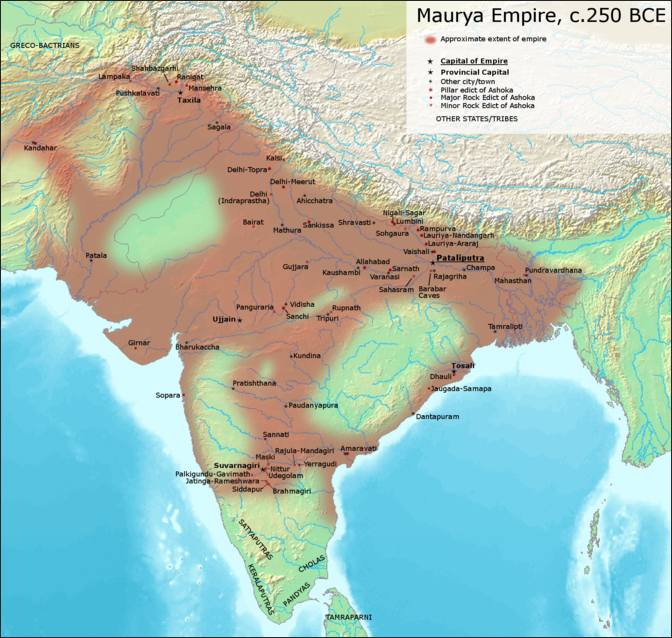
Ashoka’s Wives and Family
Various sources mention five consorts of Ashoka: Devi,
Karuvaki, Asandhimitra, Padmavati, and Tishyarakshita). Kaurvaki is the
only queen of Ashoka known from his own inscriptions: she is mentioned
in an edict inscribed on a pillar at Allahabad. The inscription names
her as the mother of prince Tivara, and orders the royal officers to
record her religious and charitable donations. [Source: Wikipedia
According to the Mahavamsa, Ashoka’s chief queen was
Asandhimitta, who died four years before him. It states that she was
born as Ashoka’s queen because in a previous life, she directed a
pratyekabuddha to a honey merchant (who was later reborn as Ashoka).
Some later texts also state that she additionally gave the
pratyekabuddha a piece of cloth made by her. These texts say one day
Ashoka mocked Asandhamitta was enjoying a tasty piece of sugarcane
without having earned it through her karma. Asandhamitta replied that
all her enjoyments resulted from merit resulting from her own karma.
Ashoka then challenged her to prove this by procuring 60,000 robes as an
offering for monks. At night, the guardian gods informed her about her
past gift to the pratyekabuddha, and next day, she was able to
miraculously procure the 60,000 robes. An impressed Ashoka makes her his
favourite queen. , and even offers to make her a sovereign ruler.
Asandhamitta refuses the offer, but still invokes the jealousy of
Ashoka’s 16,000 other wives. Ashoka proves her superiority by having
16,000 identical cakes baked with his royal seal hidden in only one of
them. Each wife is asked to choose a cake, and only Asandhamitta gets
the one with the royal seal. The Trai Bhumi Katha claims that it was
Asandhamitta who encouraged her husband to become a Buddhist, and to
construct 84,000 stupas and 84,000 viharas.
According to Mahavamsa, after Asandhamitta’s death,
Tissarakkha became the chief queen. The Ashokavadana does not mention
Asandhamitta at all, but does mention Tissarakkha as Tishyarakshita.
The Divyavadana mentions another queen called Padmavati, who was the
mother of the crown-prince Kunala.
According to the Sri Lankan tradition, Ashoka fell in
love with Devi (or Vidisha-Mahadevi), as a prince in central India.
After Ashoka’s ascention to the throne, Devi chose to remain at Vidisha
than move to the royal capital Pataliputra. According to the Mahavmsa,
Ashoka’s chief queen was Asandhamitta, not Devi: the text does not talk
of any connection between the two women, so it is unlikely that
Asandhamitta was another name for Devi. The Sri Lankan tradition uses
the word samvasa to describe the relationship between Ashoka and Devi,
which modern scholars variously interpret as sexual relations outside
marriage, or co-residence as a married couple.
Tivara, the son of Ashoka and Karuvaki, is the only of
Ashoka’s sons to be mentioned by name in the inscriptions. According to
North Indian tradition, Ashoka had a son named Kunala.[23] Kunala had a
son named Samprati. The Sri Lankan tradition mentions a son called
Mahinda, who was sent to Sri Lanka as a Buddhist missionary; this son is
not mentioned at all in the North Indian tradition. The Chinese pilgrim
Xuanzang states that Mahinda was Ashoka’s younger brother (Vitashoka or
Vigatashoka) rather than his illgetimate son. The Divyavadana mentions
the crown-prince Kunala alias Dharmavivardhana, who was a son of queen
Padmavati. According to Faxian, Dharmavivardhana was appointed as the
governor of Gandhara. The Rajatarangini mentions Jalauka as a son of
Ashoka. According to Sri Lankan tradition, Ashoka had a daughter named
Sanghamitta, who became a Buddhist nun.
Perry Garfinkel wrote in National Geographic: “As
Buddhism migrated out of India, it took three routes. To the south,
monks brought it by land and sea to Sri Lanka and Southeast Asia. To the
north, they spread the word across Central Asia and along the Silk Road
into China, from where it eventually made its way to Korea and Japan. A
later wave took Buddhism over the Himalaya to Tibet. In all the
countries, local customs and cosmologies were integrated with the
Buddhist basics: the magic and masks of demon-fighting lamas in Tibet,
the austerity of a Zen monk sitting still as a rock in a perfectly raked
Japanese garden. Over centuries Buddhism developed an inclusive style,
one reason it has endured so long and in such different cultures. People
sometimes compare Buddhism to water: It is still, clear, transparent,
and it takes the form and color of the vase into which it’s poured.”
[Source: Perry Garfinkel, National Geographic, December 2005]
Battle of Kalinga
The Battle of Kalinga in the 260s B.C. was fought India
between the Maurya Empire under Ashoka and the state of Kalinga, an
independent feudal kingdom located on the east coast, in the present-day
state of Odisha. It included one of the largest and bloodiest battles
in Indian history. The conflict was the only major war Ashoka engaged in
after his accession to the throne and the battle marked the close of
empire building and military conquests of ancient India that began with
Maurya king Bindusara. The death and destruction caused by the battle is
said to have led to Ashoka decision to adopt Buddhism. [Source:
Wikipedia]
The war was completed in the eighth year of Ashoka’s
reign, according to his own Edicts of Ashoka, probably in 262 B.C. The
battle took place after a bloody battle for the throne following the
death of his father, Ashoka prevailed and conquered Kalinga – but the
consequences of the savagery changed Ashoka’s views
According to PBS: “The Battle of Kalinga, an east coast
kingdom in modern Orissa, marked a turning point in the rule of the
Mauryan emperor, Ashoka the Great (c. 269–233 B.C.). In about 261 B.C.,
Ashoka fought a bloody war for the kingdom, a conquest he records in the
thirteenth and most important of his Fourteen Rock Edicts. In the
edict, he numbered the conflict’s casualties and prisoners at more than
200,000 and expressed remorse for this massive loss of life and freedom.
He renounced war for conquest through righteousness, dharma: “They
should only consider conquest by dharma to be a true conquest, and
delight in dharma should be their whole delight, for this is of value in
both this world and the next.” Dharma became the organizing principle
of Ashoka’s personal and public life and shaped his policies of
non-violence and religious tolerance. [Source: PBS, The Story of India,
pbs.org/thestoryofindia]
Ramesh Prasad Mohapatra wrote in “Military History of
Orissa”: “No war in the history of India as important either for its
intensity or for its results as the Kalinga war of Ashoka. No wars in
the annals of the human history has changed the heart of the victor from
one of wanton cruelty to that of an exemplary piety as this one. From
its fathomless womb the history of the world may find out only a few
wars to its credit which may be equal to this war and not a single one
that would be greater than this. The political history of mankind is
really a history of wars and no war has ended with so successful a
mission of the peace for the entire war-torn humanity as the war of
Kalinga.”
Dhauligiri (or Dhauli, eight kilometers miles from
Bhubaneswar) is where the Battle of Kalinga was fought. Situated by Daya
Stream, the main attraction are the rock edicts and Peace Pagoda, or
Dhauli Shanti Stupa, a large white stupa made in collaboration with the
Japanese. From the top of the hill on which the stupa stands one can
scan the famous battle field. On the rock there is an inscription of an
elephant, the symbol of Buddha, reputedly placed there by Ashoka himself
Kalinga and the Background of the Battle
Kalinga is mentioned in the ancient scriptures as
Kalinga the Braves (Kalinga Sahasikha). During the 3rd century B.C. the
Greek ambassador Megasthenes in his tour of India had mentioned about
the military strength of the Kalinga army of about one lakh which
consisted of 60 thousand soldiers, 1700 horses and thousands of
elephants. Kalinga was also powerful in the naval force. The vast
military strength of Kalinga was the cause of jealousy for the Magadha
empire. According to the historians the Magadha Emperor Ashoka invaded
Kalinga in 261 B.C. Nearly one lakh soldiers lost their lives in the
Kalinga War and one and half lakh soldiers were captured.
During Ashoka’s invasion the capital of Kalinga was
Toshali near Dhauli. The vast wealth, military power and the maritime
activities of the Kalinga was the cause of jealousy for the Magadha
empire. Though both Emperor Chandragupta Maurya and Bindusar wanted to
conquer Kalinga, neither ventured a war with Kalinga.
After the death of Ashoka, the Great Kharavela became
the emperor of Kalinga. He was the monarch of the Chedi Dynasty. The
inscription found in the Elephant Caves of Khandagiri and Udaigiri
mountains near Bhubaneswar describes in detail the reign of Emperor
Kharavela.
Kalinga did not have a king at the time of the battle as
it was culturally run without any. The reasons for invading Kalinga
were both political and economic. Kalinga was a prosperous region
consisting of peaceful and artistically skilled people. Known as the
Utkala, they were the first from the region who traveled offshore to the
southeast for trade. For that reason, Kalinga had important ports and a
powerful navy. They had an open culture and used a uniform civil code.
Kalinga was under the rule of the Nanda Empire until
the empire’s fall in 321 B.C. Ashoka’s grandfather Chandragupta Maurya
had previously attempted to conquer Kalinga, but had been repulsed.
Ashoka set himself to the task of conquering the newly independent
empire as soon as he felt he was securely established on the throne.
Kalinga was a strategic threat to the Maurya empire. It could interrupt
communications between Maurya capital Pataliputra and Maurya possessions
in central Indian peninsula. Kalinga also controlled the coastline for
the trade in bay of Bengal.
Impact of the Battle of Kalinga
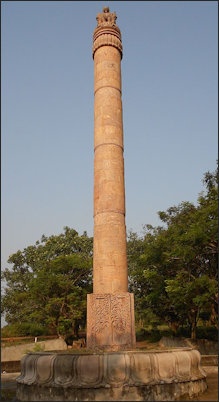
Ashoka’s Lion Pillar on the way to the Dhauli Giri
Ashoka was shocked by the bloodshed and felt that he
was the cause of the destruction. The whole area of Kalinga was
plundered and destroyed. Some of Ashoka’s later edicts state that about
150,000 people died on the Kalinga side and an almost equal number of
Ashoka’s army, though legends among the Odia people – descendants of
Kalinga’s natives – claim that these figures were highly exaggerated by
Ashoka. According to their legends, Kalinga armies caused twice the
amount of destruction they suffered. Thousands of men and women were
deported from Kalinga and forced to work on clearing wastelands for
future settlement.
The war and led Ashoka to pledge to never again wage a war of conquest.
Ashoka, Rock Edict No. 13 reads: “Beloved-of-the-Gods, King Priyadarsi,
conquered the Kalingas eight years after his coronation. One hundred and
fifty thousand were deported, one hundred thousand were killed and many
more died (from other causes). After the Kalingas had been conquered,
Beloved-of-the-Gods came to feel a strong inclination towards the
Dharma, a love for the Dharma and for instruction in Dharma. Now
Beloved-of-the-Gods feels deep remorse for having conquered the
Kalingas.
The Battle of Kalinga prompted Ashoka, already a
non-engaged Buddhist, to devote the rest of his life to ahimsa
(non-violence) and to dharma-vijaya (victory through dharma). Following
the conquest of Kalinga, Ashoka ended the military expansion of the
empire and began an era of more than 40 years of relative peace,
harmony, and prosperity.
The Battle of Kalinga took place during eighth year of
Ashoka’s reign. Rama Shankar Tripathi wrote: “We have ventured the
surmise elsewhere that the power of the Nandas extended to this region,
and hence it must have asserted its independence in the confusion
accompanying their overthrow, or during the disturbed reign of
Bindusara. Thus, the task of recovering it fell to the lot of Ashoka.
The Kalinga people offered stubborn resistance, for we learn from R.
E. XIII that in the conflict no less than “one hundred and fifty
thousand persons were captured, one hundred thousand were slain, and
many times that number died,” perhaps of privation and pestilence. But
nothing availed them, and their country was ruthlessly pillaged and
conquered.” [Source: “History of Ancient India” by Rama Shankar
Tripathi, Professor of Ancient Indian History and Culture, Benares Hindu
University, 1942]
Extent of Ashoka’s Empire
It is well known that Kalinga was the only conquest of
Ashoka. But he had inherited an enormous empire from his predecessors,
and its limits may be fixed with tolerable accuracy. On the north-west,
it certainly extended to the Hindu Kush, for there is every reason to
believe that he retained the four satrapies of Aria (Herat), Arachosia
(Kandahar), Gedrosia (Baluchistan), and Paropanisadas (Kabul valley),
which were ceded to his grand-father by Selcukos Nikator. That
Southern Afghanistan and the frontier regions continued to form part of
Ashoka’s vast realm is clear from the findspots of his rock-edicts in
Shahbazgarhi (Peshawar district) and Mansehra (Hazara district), as also
from the evidence of Xuanzang who refers to the existence, of Ashokan
Stupas in Kafiristan (Kapisa) and Jalalabad. [Source: “History of
Ancient India” by Rama Shankar Tripathi, Professor of Ancient Indian
History and Culture, Benares Hindu University, 1942]
Further, the inclusion of Kashmir is deposed by the
Chinese pilgrim, Xuanzang. It may be interesting to add here that the
foundation of Srlnagar is ascribed to Ashoka, who is also credited with
having built numerous Stupas and Caitjas in the valley. The
inscriptions of Ashoka at Girnar and Sopara (Thana district)
definitively point to his jurisdiction over Saurastra and the
south-western regions. Besides, we also know from the Junagadh rock
inscription of Rudradaman that Yavanaraja Tusaspa 1 was Ashoka’s
Viceroy in Saurastra.
In the north, Ashoka’s authority extended up to the
Himalaya mountains. This is apparent from his edicts, which have been
found at Kalsi (Dchradun district), Rummindei and Nigliva (Nepalese
Tarai). Tradition also attributes to Ashoka the foundation of
Lalitapatart in Nepal, where he went with his daughter Carumatl and
her husband Devapala Ksatriya.
Eastwards, Bengal was comprised within his empire.
Xuanzang noticed several Ashokan Stupas in the different parts of
Bengal, and according to legends Ashoka went as far as Tamralipti
(Tamluk) to see his son and daughter off to Ceylon. Kalinga, which was
the only conquest of the Emperor, was, of course, included. Here he
got two edicts inscribed — one at Dhauli (Puri district) and the other
at Jaugada (Ganjam district). The inclusion of Bengal in the Mauryan
Empire further receives some confirmation from the Mahasthan (Bogra
district) Pillar Inscription, engraved in Brahmi characters of the
Mauryan period.
Towards the south, Ashoka’s rock inscriptions have
been discovered in Maski and Iragudi in the Nizam’s dominions, and
Chitaldroog district in Mysore. Beyond this, there were the independent
kingdoms of the Cholas, the Pandyas, the Satiyaputras, and the
Keralaputras (R. E. if).
Lastly, the edicts contain references to some of the
towns 6f the empire, viz,, Bodhgaya, Taksasila (Taxila), Tosali,
Samapa, Ujjayini, Suvarnagiri (Songir or Kanakagiri), Isila, Kau6ambi,
Pataliputra. All these evidences indicate that the empire extended from
the Hindu-Kush in the north-west to Bengal in the east; and from the
foot of the mountains in the north to the Chitaldroog district in the
south. It also comprised the two extremities of Kalinga and Saurastra.
Indeed, it was of such imposing dimensions that Ashoka was fully
justified in saying “mahalake hi vijitam”, i.e., “vast is my empire”
(R. E. XIV). No king in ancient India was ever master of such extensive
territories.
Government and Society Under Ashoka
The administrative system under Ashoka remained more or
less the same as in the time of Chandragupta Maurya. It was an
absolute benevolent monarchy, and Ashoka laid special stress upon the
paternal principle of government. In the second Kalinga Edict he says:
“All men are my children, and just as I desire for my children that
they may enjoy every kind of prosperity and happiness both in this world
and in the next, so also do I desire the same for all men.” As before,
there was a council of Ministers (Parisad) to advise and help the
Emperor in the business of the state (R. E. Ill and VI). [Source:
“History of Ancient India” by Rama Shankar Tripathi, Professor of
Ancient Indian History and Culture, Benares Hindu University, 1942]
Ashoka continued also the system of Provincial
Administration. The important provinces were each under a prince of the
blood royal (Kumara). We learn from the edicts that Taxila, Ujjayini,
Tosali (Dhauli), and Suvarnagiri (Songir) were such scats of viceroyalty
during Ashoka’s reign. Sometimes, however, trusted feudatory chiefs
were appointed to the exalted viceregal offices, as is proved by the
case of Raja Tusaspa, the Yavana, who had his capital at Girnar.
Presumably, the Viceroys had their own ministers (. Amaiyas). At any
rate, it was against the latter that the people of Taxila revolted in
the time of Bindusara. The minor provinces were under governors,
perhaps the Rajukas of the edicts.
Ashoka introduced a number of administrative
innovations for good governance. He created the new office of
Dbamma-Mabamdtas for the temporal and spiritual weal of his subjects.
They were to look after the interests of the different religious groups
and the distribution of charities, and also to mitigate the rigours
of justice by securing reduction in penalties or release from
imprisonment on the ground of age or numerous progeny, and by
preventing any undue harassment. He allowed the Vativedakas (Reporters)
to inform him about urgent public matters at all times wherever he may
be (R.E. VI). Ashoka granted to the Rajukas, “set over many hundred
thousands of people”, independence in the award of honours and
punishments datnde) in order that they might discharge their duties
confidently and fearlessly. They were, however, expected to maintain
uniformity in penalties as well as in judicial procedure. Lastly, the
Emperor released prisoners on the anniversary of his coronation (P.E.
V), and gave three days’ respite to those sentenced to death (P.E. IV).
We get some glimpses of society as constituted in
Ashoka’s time. It comprised religious orders like the Brahmanas,
Sramanas, and other Pasandas, among which the Ajlvikas and the
Nirgranthas (Jains) were the most prominent. These monks and ascetics
spread the truth as they conceived it, and promoted the cause of
learning by instruction and discussion. Besides, there were the
householders and curiously the edicts mention all the four divisions,
viz., Brahmanas; soldiers and their chiefs, corresponding to Ksatriyas;
Ibhyas or Vaisyas; and slaves and servants, i.e., Sudras. The people
were wont to perform many ceremonies to bring them good luck, and they
believed in the hereafter. Meat-eating must have undoubtedly been a
common feature of society, as appears from the comprehensive
regulations laid down by Ashoka for preventing slaughter of animals
(P.E. V). The “upper ten” perhaps practised polygamy, if the case of
Ashoka himself furnishes any analogy. The references to harems in R.E.
V would show that the segregation and restrictions upon the freedom of
women-folk were then not unknown. [Source: “History of Ancient India”
by Rama Shankar Tripathi, Professor of Ancient Indian History and
Culture, Benares Hindu University, 1942]
Ashoka’s Achievements and Reforms
His achievements were not only his victories of
“Dharma”, but also on his achievements in the domain of art and
architecture. Tradition credits him with the foundation of two cities,
Srinagar in Kashmir and Lalitpur (the third largest city of Nepal
after Kathmandu and Pokhara). . He also made, as noted by Faxian,
considerable additions to the grandeur of his palace and the
metropolis. He built a large number of Stupas throughout his far-flung
empire to enshrine the corporeal relics of the Buddha. After the
cremation of the Buddha’s remains his ashes were shared by eight
claimants, who each raised a Stupa over them. These were opened by
Ashoka, and, as the legend goes, he re-distributed the relics among
84,000 Stupas, which he himself built for the purpose. In addition,
Ashoka undertook the construction of Viharas or monasteries and
cave-dwellings for the residence of monks. Unfortunately, however, the
extant evidence of his building activities is very scanty.
[Source:“History of Ancient India” by Rama Shankar Tripathi, Professor
of Ancient Indian History and Culture, Benares Hindu University, 1942]
Ven. S. Dhammika wrote: The judicial system was
reformed in order to make it more fair, less harsh and less open to
abuse, while those sentenced to death were given a stay of execution to
prepare appeals and regular amnesties were given to prisoners. State
resources were used for useful public works like the importation and
cultivation of medical herbs, the building of rest houses, the digging
of wells at regular intervals along main roads and the planting of fruit
and shade trees. To ensue that these reforms and projects were carried
out, Ashoka made himself more accessible to his subjects by going on
frequent inspection tours and he expected his district officers to
follow his example. To the same end, he gave orders that important state
business or petitions were never to be kept from him no matter what he
was doing at the time. The state had a responsibility not just to
protect and promote the welfare of its people but also its wildlife.
Hunting certain species of wild animals was banned, forest and wildlife
reserves were established and cruelty to domestic and wild animals was
prohibited. The protection of all religions, their promotion and the
fostering of harmony between them, was also seen as one of the duties of
the state. It even seems that something like a Department of Religious
Affairs was established with officers called dharma Mahamatras whose job
it was to look after the affairs of various religious bodies and to
encourage the practice of religion. [Source: “Edicts of King Ashoka:
An English Rendering” by Ven. S. Dhammika, Buddhist Publication Society,
Kandy Sri Lanka, 1993]
Ashoka’s Personal Religion

Ashoka rock edict in Gujarat
It is said that in the 3rd century B.C., the great
Emperor Ashoka was sent to Ujjain by his father Bindusara to subdue an
uprising. He was injured and was treated by Buddhist monks, the king’s
first encounter with Buddhism, a religion he later converted India.
Ashoka appears to have never renounced the world, nor ever became a
monk, as suggested by some scholars on the authority of the Divjavadana
and of I-tsing, Ashoka’s pilgrimages to Sarnath, where the Buddha first
“turned the wheel of the Law,” and to Kushinagar,where Buddhists
believe Gautama Buddha attained Parinirvana after his death, are not
mentioned in his inscriptions.
Ashoka’s link with Buddhism is mainly associated with
Kalinga. He himself declares in R.E. XIII that “directly after the
conquest of the Kalihgas, the Beloved of the gods became zealous in the
pursuit of dharma, love for dharma, and teaching of dharma.” Rama
Shankar Tripathi wrote: Sometimes it is doubted if he was a Buddhist,
but his attachment to Buddhism is apparent from authentic traditions
as well as cpigraphic evidence. In the Bhabru edict he professes
devotion to the Buddhist Trinity — the Buddha, the dharma, and the
Samgha — and recommends both the Order and the laity certain sections
from the Buddhist scriptures for their recitation and meditation.
In the minor pillar edict at Sarnath and its variants,
Ashoka speaks almost as the Defender of the Faith, prescribing
penalties for any attempts to create schisms in the church. He also
performed pilgrimages to Buddhist holy places like Bodhgaya (R. E.
VIII) and Lumbini (M. P. E.), and abolished sacrifices and amusements
which involved the slaughter of innocent animals (R. E. I.). Lastly, we
learn from traditions that Ashoka built a large number of Stupas to
enshrine the relics of the Buddha, originally deposited in eight such
structures; and to further the cause of Buddhism and settle the canon
the Emperor convoked a council, too, under the leadership of
Moggaliputta Tissa. [Source: “History of Ancient India” by Rama Shankar
Tripathi, Professor of Ancient Indian History and Culture, Benares Hindu
University, 1942]
Tolerance of Religion in Ashoka’s Empire
Though Ashoka had himself embraced Buddhism, he was by
no means an intolerant zealot. On the contrary, he bestowed due honours
and patronage on all the sects then prevailing. He granted
cavedwellings to the Ajivikas, and inculcated the virtues of liberality
and seemly behaviour towards the votaries of different creeds —
Brahmanas, Sramanas, Nirgranthas, etc. He believed that the followers of
all sects aimed at “restraint of passions and purity of heart,” and,
therefore, he desired that they should reside everywhere in his empire
(R. E. VII). Above all, he exhorted his subjects to exercise
self-control, be “bahuSruta,” i.e., have much information about the
doctrines of different sects, and avoid disparaging any faith merely
from attachment to one’s own, so that there may be a growth in mutual
reverence and toleration (R. E. XII). Truly, these are lofty
sentiments, which may bring solace even to the modern distracted world.
[Source: “History of Ancient India” by Rama Shankar Tripathi, Professor
of Ancient Indian History and Culture, Benares Hindu University, 1942]
Owing to this catholicity Ashoka did not seek to
impose his personal religion upon the people. Indeed, nowhere in his
edicts does he mention the chief characteristics of Buddhism, to wit,
the Four Noble Truths, the Eightfold Path, and the goal of Nirvana. The
“Dharma”, which he presents to the world is, so to say, the essence or
sara of all religions. He prescribes a code of conduct with a view to
making life happier and purer. He laid great stress on obedience and
respect for parents, preceptors, and elders. Liberality and proper
treatment of Brahmanas, relations, friends, the aged, and the
distressed, were highly commended. Ashoka defines the “Dharma” as
comprising charity, compassion, truthfulness, purity, saintliness.
self-control, gratitude, steadfastness, and so on. Negatively, it is
freedom from sin, which is the outcome of anger, cruelty, pride), and
jealousy. These ate points common to all religions, and so Ashoka can
hardly be accused of utilising his vast resources as sovereign in the
interests of any particular creed. To him, therefore, goes the credit
of first conceiving the idea of a universal religion, synonymous with
Duty in its broadest sense. [Source: “History of Ancient India” by Rama
Shankar Tripathi, Professor of Ancient Indian History and Culture,
Benares Hindu University, 1942]
Ashoka did not, however, give to all the current
religious practices and beliefs the stamp of his recognition. In
pursuance of the principle of non-injury to sentient beings, he did not
hesitate to suppress entirely the performance of sacrifices
accompanied with the slaughter of animals (R. E. I). This may have
meant a real hardship to some of his people, who believed in their
efficacy, but Ashoka was not prepared to make any compromise on this
cardinal doctrine. He also condemned certain ceremonies as trivial,
vulgar, and worthless. Mostly they were performed by womenfolk on
occasions of births, deaths, marriages, journeys, etc. According to
Ashoka, true ceremonial consisted of proper conduct in all relations of
life. Similarly, he tried to change the popular idea of gifts and
conquests. He declares that there is no such gift as dharma-d&na,
which consists of “proper treatment of slaves and servants, obedience
to mother and father, liberality to friends, companions, relations,
Brahmana and Sramana ascetics, and abstention from slaughter of living
creatures for sacrifice”
Ashoka Promotion of Buddhism and the Third Buddhist Council

Ashoka propagated the “Dharma” with the zeal and
earnestness of a missionary, and he claims in Minor Rock Edict I that
as a result of his strenuous exertions for a year, indeed for more than
a year, “human beings who were unmixed were caused to be mixed with
gods throughout Jambudvlpa.” He achieved this extraordinary success on
account of his well-planned measures. He exhibited “spectacles” of
celestial chariots, luminous balls of fire, and elephants, representing
the kinds of bliss, which the virtuous enjoyed in heaven. He believed
that these shows would attract people to the path of righteousness. He
himself gave up pleasure-tours, consisting of hunting and other
diversions, and substituted for them “ dharmaja tras” to foster dharma
and a spirit of liberality in’ the country by his precept and personal
example. [Source: “History of Ancient India” by Rama Shankar Tripathi,
Professor of Ancient Indian History and Culture, Benares Hindu
University, 1942]
Ashoka embarked on a programme of benevolent
activities to relieve the distress of man and beast. We have already
referred to his prohibition of sacrificial slaughter, and R. E. I
further says that he gradually eliminated the non-vegetarian items from
the royal menu. All Samajas, involving meat-eating, dancing, music,
etc., were strictly stopped. Similarly, P. E. V. mentions certain
regulations which he prescribed in order to restrict the killing and
mutilation of animals. He gave largess to ascetics, the poor, and the
oppressed; and he employed superior officers (Mukhas) for supervising
his charities as well as those of his queens and the princes. According
to R. E. II, Ashoka instituted “medical treatment” of two kinds — one
for human beings and the other for the lower creation — in his
dominions and in those of his frontier neighbours.
One of the notable events, which took place in the
17th year of Ashoka’s coronation, was the convocation of the third
Buddhist council to resolve the differences between the various sects of
Buddhism. It met at Pataliputra (near present-day Patna) and after
nine months’ deliberations the issues were decided in favour of the
Sthaviras (an early Buddhist school).
Buddhism Spreads Out of India
At the conclusion of the Third Buddhist Council, the
council leader organised and dispatched evangelical missions to distant
lands. For instance, Majjhantika went to Kashmir and Gandhara, Majjhima
led the party to the Himalaya country, Mahadeva was deputed to
Mahisamandala (Mysore), Sona and Uttara to Suvarnabhumi (Burma),
Mahadharmaraksita and Maharaksita were sent to Maharastra and the
Yavana country respectively, and Ashoka’s son Mahendra, who had become a
monk, was sent along with others to Lanka (Ceylon). Subsequently the
Emperor’s daughter, Samghamitra, is said to have taken there a branch
of the sacred Bodhi Tree. The propagation and promotion of Buddhism in
Ashoka’s time must have largely been due to the zeal and perseverance
of these indefatigable missionaries. [Source: “History of Ancient India”
by Rama Shankar Tripathi, Professor of Ancient Indian History and
Culture, Benares Hindu University, 1942]
Steven M. Kossak and Edith W. Watts from The
Metropolitan Museum of Art wrote: ““In the first century A.D., the
Kushans, nomadic warriors from Central Asia, conquered the ancient
Gandharan region (which includes parts of modern Pakistan and
Afghanistan) and much of northern India. Different styles of art emerged
from the two Kushan capitals, one in the Peshawar area of Gandhara and
the other at Mathura further southeast in India. The Gandharan style
adapted forms from late Hellenistic and Roman art, perhaps a legacy of
Alexander the Great’s successors in the area, but largely because the
major trade routes from the Roman Empire to India and China passed
through the region, bringing peoples and ideas from the West. [Source:
Steven M. Kossak and Edith W. Watts, The Art of South, and Southeast
Asia, The Metropolitan Museum of Art, New York <>]
“In Andhra, on the southeastern coast of India, the
Ikshvaku kingdom (A.D. 1st– 3rd century) prospered through the exchange
of goods from local ports on the sea routes to Rome. There, as in
Gandhara, Buddhist merchants and devotees financed the building of
stupas decorated with narrative stone reliefs depicting the Buddha in a
distinctive fashion. Andhran Buddhist art influenced the art styles of
Sri Lanka and images of the Buddha in Andhran style have been found in
Thailand, Vietnam, and Indonesia. By the end of this period, Buddhism
was spreading along the silk route to China and later to Korea and
Japan. Along with written accounts of the Buddha’s teachings (called
sutras), monks and merchants carried small portable works of art—mainly
sculptures of Buddhas, bodhisattvas, and shrines—which greatly
influenced early Chinese and Central Asian Buddhist sculpture. <>
The Chinese monk Fa-hsien ventured as far west as India
around A.D. 400 to study Buddhism. He traveled from Xian to the west
overland and cross into India over Himalayan passes and sailed back to
China on route that took him through present-day Indonesia. The the
spread of Buddhism—a peaceful process in itself—periodically met with
hostility. In China, in A.D. 842, the Tang Emperor Wuzong began to
persecute foreign religions. Some 4,600 Buddhist monasteries were
annihilated, priceless works of art were destroyed, and about 260,000
monks and nuns were forced to return to lay life.
Hindu Revival and the Death of Buddhism in India

Khalsi Ashoka rock edict
Centuries after took hold in India Hinduism made a
comeback in India namely at Buddhism’s expense. Vedic traditions were
combined with the worship of a multitude of indigenous gods (seen as
manifestations of Vedic gods), the caste system was reintroduced and
Buddhism gradually disappeared. Before its final decline in India,
Buddhism developed the popular worship of enlightened beings (heavenly
Bodhisattvas), produced a refined architecture (stupas and shrines) at
Sanchi. By the 11th century Buddhist had disappeared from India. . The
Muslim invasions may have played a role in its demise there
The Gupta Empire (A.D. 320 to 647) was marked by the
return of Hinduism as the state religion. The Gupta era us regarded as
the classical period of Hindu art, literature and science.
After Buddhism died out Hinduism returned in the form of a religion
called Brahmanism (named after the caste of Hindu priests). Vedic
traditions were combined with the worship of a multitude of indigenous
gods (seen as manifestations of Vedic gods). The Gupta king was
worshiped as a manifestation of Vishnu, and Buddhism gradually
disappeared. The caste system was reintroduced. Brahmans held great
power and became wealthy landowners, and a great many new-castes were
created, in part to incorporate the large number of foreigners that
moved into the region.
Buddhism all but disappeared from India by the A.D. 6th
century. Attempts to reform Hinduism only led to new sects that still
follow the basic tenets of the Hindu mainstream. During medieval times,
when Hinduism was influenced and threatened by Islam and Christianity,
there was a movement toward monotheism and away from idolatry and the
caste system. The cults of Rama and Vishnu grew in the 16th century out
of this movement, with both deities being regarded as supreme gods. The
Krishna cult, known for its devotional chants and song meetings,
highlighted Krishna’s erotic adventures as a metaphor for the
relationship between mankind and God. [ World Religions edited by
Geoffrey Parrinder, Facts on File Publications, New York]
Image Sources: Wikimedia Commons
Text Sources: New York Times, Washington Post, Los Angeles Times, Times
of London, Lonely Planet Guides, Library of Congress, Ministry of
Tourism, Government of India, Compton’s Encyclopedia, The Guardian,
National Geographic, Smithsonian magazine, The New Yorker, Time,
Newsweek, Reuters, AP, AFP, Wall Street Journal, The Atlantic Monthly,
The Economist, Foreign Policy, Wikipedia, BBC, CNN, and various books,
websites and other publications.
Last updated September 2020












